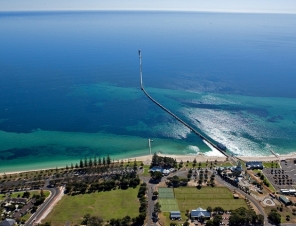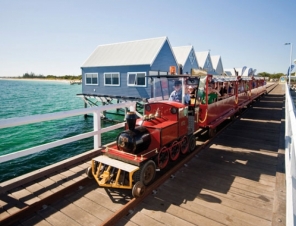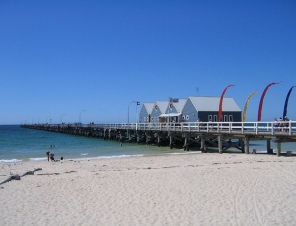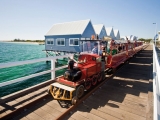Busselton is 220 kilometres [140 miles] south west of Perth, the capital of Western Australia and it has been voted Western Australia's top tourist town three times in 1995, 1996 and 2005.
The early history of European exploration of the area focuses on the French expedition of 1801 which brought Nicholas Baudin, with his ships the Geographe and Naturaliste, to the coast of Western Australia. Baudin named Geographe Bay and Cape Naturaliste after his vessels, and named the river Vasse after a sailor, Thomas Vasse, who was lost as he went overboard and believed to have drowned.
Busselton was one of the earliest settlements in Western Australia and was was first settled by the Bussell family in 1834, establishing a cattle station which they named Cattle Chosen, which quickly became one of the most prosperous stations in the colony.
Being in close proximity to the tall timber country, Busselton soon established itself as a leading port and from 1850, timber was being exported and the small town prospered. Jetties for this purpose were built at Wonnerup, Busselton and Quindalup, of which only the Busselton Jetty remains.
Busselton experiences a Mediterranean climate and enjoys moderate temperatures, with an average maximum temperature of 22 degrees celsius. The summers are generally hot, with an average daily maximum of 28 degrees celsius with cooling afternoon sea breezes. The annual average rainfall for Busselton is 864 mm, with the wettest period being from May to September.
The city is home to the longest wooden jetty or pier in the southern hemisphere, stretching almost 2 km out to sea. Construction of the jetty began in 1853 and was continually extended until the 1960's when it reached its current length of 1841 metres. It was closed to shipping in 1972, and maintenance was discontinued for a time. It has since been restored, and is now the site of an underwater observatory and an interpretive centre.



Busselton Cruise Port
Famous for its almost 2km long wooden jetty
Busselton City is in the South West region of Western Australia. Founded in 1832 by the Bussell family, Busselton has been one of the fastest growing regions in Australia in the last decade and has a population of approximately 20,000. Ships are now beginning to call here now that better tendering facilities are being created.

Quick Search


 |
|









